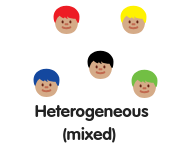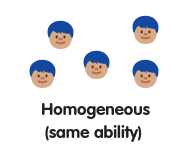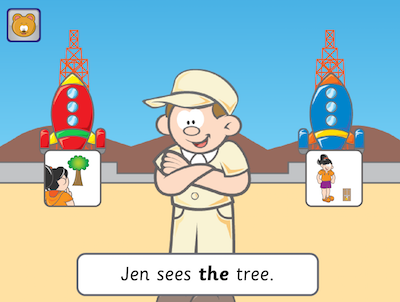
In most classrooms there is a 3-4 year range of spelling skills, which makes the provision of appropriate spelling instruction challenging. Most teachers will already have ‘reading groups’, as they are conscious of the range of reading ability within one classroom. Additionally, difficulties in spelling often persist longer than reading difficulties. This is because reading requires only recognition whereas spelling requires production.
One of the ways in which a teacher can cater to a wide variety of needs is by ability grouping, but the appropriateness of such an approach is still being debated. This blog will discuss the pros and cons of two methods of grouping students for spelling instruction – heterogeneous and homogeneous.


The term ‘achievement’ is probably more appropriate than ‘ability’ as a number of students do not perform to intellectual ability for one reason or another.
Over the years, logic, emotion and research have frequently clashed in debate on the advantages and disadvantages of ability grouping. Ability grouping, and, in particular ‘tracking’, fell out of favour in the late 1980s and 1990s in much of the English-speaking world as critics said that it ‘stigmatised’ and perpetuated inequality by ‘trapping’ academically challenged, minority and economically challenged students in low-level groups. The impact of ability grouping on the fulfilment of the potential of gifted students seems to have attracted little attention.
There is limited consensus in the research on ability grouping. Some research studies suggest that the ‘labelling’ that results from ability grouping can damage the self-esteem of those with lower ability and that expectations linked to those labels can be a self-fulfilling prophecy. Others suggest that it produces the opposite effect by ensuring that more advanced students do not make their less advanced peers feel inadequate. Some studies conclude that ability grouping improves test scores in students of all levels, many that it helps high-achieving students more than low-achieving ones, and others that it has little effect.
John Hattie, who synthesised results of more than 15 years’ research in his book Visible Learning, ranked influences on student achievement, from 1 to 150, with 1 being the most influential. It is interesting to note his rankings of grouping practice:
 The influence of grouping by ability on achievement.
The influence of grouping by ability on achievement.So how should teachers group students? I believe that there are certain qualifiers to be considered.
The influential American psychologist Dr Robert E.Slavin (creator of the ‘Success For All’ educational model) found that grouping students by ability for all subjects does not improve achievement. Students grouped heterogeneously for most of the school day, but regrouped according to ability for one or two subjects, can improve achievement in those areas for which they are grouped. He found, for example, that ability grouping for Reading and Maths can benefit student achievement, be that in the form of in-class ‘break-out’ groups or separate classes. It makes logical sense that Spelling would be another subject for which ability grouping would be beneficial. Encoding (Spelling) is the reciprocal of decoding (Reading). Spelling and Reading share the same alphabetic code. Letters, symbols and numbers are the primary methods of human communication.
Whether to form groups with students of similar or mixed ability depends on the purpose of the learning activity (Robert Marzano, Debra Pickering, and Jane Pollock in Classroom Instruction That Works). Investigations, construction projects, problem-solving, discussions and creative tasks can benefit from a mix of student strengths and interests. They are open-ended tasks with no one correct response. Spelling is a very different sort of task, with a correct response the goal and rules to be followed. It is important that the student knows the rules and is able to achieve accuracy, even when a spelling activity involves discussion and problem-solving, such as a word sort.
Ability grouping can be very effective but it must be based on up-to-date, non-subjective test results. In the case of Spelling, this would mean pre-tests of regular and irregular words and calculation of word spelling accuracy percentage in sentence writing (check out my post on assessment). There must be frequent re-evaluation of skills and knowledge and movement to another group must be possible based on performance in those regular assessment checks. Flexible grouping has its roots in formative assessment (0.9 effect size) and Response to Intervention (1.07 effect size). Students should be made aware that ability grouping is designed to take them from the level at which they are currently operating to the next level and should be helped to set and achieve realistic goals. Academic rigour and expectations must be kept high for each group.
What is done when students are grouped is more directly related to achievement than just being placed in a group. Teachers are expected to differentiate content, process, product and the learning environment to address individual needs in their classroom. This is certainly easier to do with homogeneous grouping, be it within the same classroom or in separate learning areas.
Unfortunately, I often see a heterogeneously grouped class of students working on the same spelling list on the page of a commercially-produced grade-level Spelling workbook, with the only ‘nod’ to differentiation being that the struggling spellers are expected to learn fewer words and the gifted and talented spellers have some theme or ‘personal’ words added to their spelling list. The students do the same activities. Some schools differentiate the spelling list/focus pattern but the students all do the same activities in the same classroom.
I have worked with students with specific learning difficulties in the area of literacy, and students gifted in literacy skills, for over 35 years and I can tell you, based on that experience, that a ‘nod’ to differentiation is not adequate. If content and process are not differentiated, the struggling speller is unlikely to make the progress seen in the middle ability students. Students who are performing well below grade/age level typically need highly-structured, cumulative, multi-sensory synthetic phonics instruction that is more intensive, more frequent and of longer duration than that of their peers. The words they study should contain only the letter-sound correspondences and irregular words they have already mastered and the focus correspondence / irregular words being explicitly taught, like in the Phonics Hero example below.
 An example from Phonics Hero: this game targets the /ee/ sound
An example from Phonics Hero: this game targets the /ee/ sound In a heterogeneous grouping of students, there is a tendency to think that students already showing strong spelling skills need little instruction and will just whizz through what has been set for the class and then get on with another task (or help other students). I have worked with gifted students who have developed behaviour problems, who suffer from anxiety and depression, even some who are literally suicidal, because the content, pace and product in instruction is so mind-numbingly below their ability level. There are thousands of gifted students underachieving in our schools. The gifted speller should be working on words not already mastered. The only way to identify these is to do off-level testing. The focus of instruction, depending on intellectual ability, should be multiple representations of a sound, homophones, word-building with affixes, word-webbing that develops vocabulary, etymology, even looking for similarities between languages. The activities the gifted speller undertakes should be qualitatively, not just quantitatively challenging, drawing on various forms of word knowledge e.g. crosswords (regular or cryptic), word ladders, word games such as Scrabble or Boggle. Once the student has demonstrated mastery, he should be allowed to move on to a new list.
It is possible to group homogeneously within a classroom. This may be seen by a student who fears labelling as more acceptable than going to another area. Each group has a turn at meeting with the teacher during the week for the introduction of the words on their list while others do activities independently from the previous week’s list. My concern about this model relates to the fact that spelling requires sounding out words in syllables and phonemes. Students who have difficulty with phonological processing, auditory processing or attention can find it hard to hear sounds when there are multiple simultaneous and different activities going on in close proximity. These students may benefit from instruction in a separate, quieter area.
Whichever grouping method is chosen, effective use of technology can facilitate high-quality differentiation within that grouping. Phonics Hero’s click-and-go Phonics Lessons allows teachers to differentiate their teaching of blending to read words and reading sentences. Watch this 1-minute whistle-stop tour of differentiation using our no-prep Phonics Lessons:
If you purchase Child Accounts for your students, you can create homogeneous groups by making ‘virtual reading groups’ – see how to do this with ‘classes’:
The games do not have year groups indicated on the levels, so children can learn at their own pace. For students who are experiencing difficulties, you can use a ‘Schedule’ to slow down the pace at which they are going through Phonics Hero. For the gifted and talented student, you can use your assessment data to start them off at any level. All students receive immediate feedback and their performance details are automatically recorded for the teacher, freeing up the teacher to work with individuals.
I believe it is appropriate to use achievement grouping for Spelling instruction as long as the content, process and materials used in the groups are differentiated and students are able to move from one group to another when the appropriate mastery of skills and knowledge is achieved. The achievement grouping might be in class or in separate areas with the ‘gifted’ and ‘struggling’ spellers offered the expertise of a specialist instructor or program. In the modern classroom, technology can be used very effectively to increase individualisation of spelling instruction.
You may find this 2013 article by a Californian teacher interesting additional reading. Additionally, in this video, phonics educator and author Ruth Miskin talks about grouping for phonics.